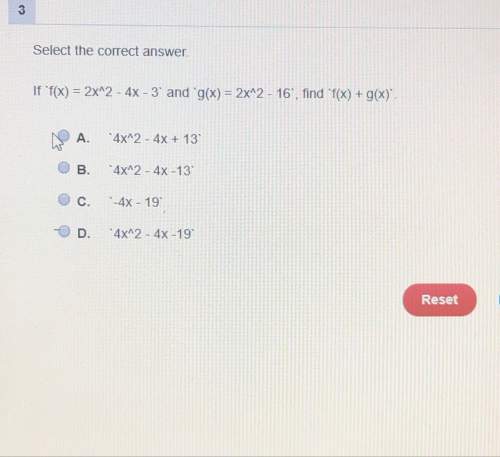
Mathematics, 06.12.2021 17:40 brinatperez06
The following data was collected to explore how the average number of hours a student studies per night and the student's GPA affect their ACT score. The dependent variable is the ACT score, the first independent variable (x1) is the number of hours spent studying, and the second independent variable (x2) is the student's GPA.
Effects on ACT Scores
Study Hours GPA ACT Score
6 4 29
5 4 24
3 3 18
2 2 18
2 2 18
1. Find the p-value for the regression equation that fits the given data.
2. Determine if a statistically significant linear relationship exists between the independent and dependent variables at the 0.01 level of significance. If the relationship is statistically significant, identify the multiple regression equation that best fits the data, rounding the answers to three decimal places. Otherwise, indicate that there is not enough evidence to show that the relationship is statistically significant.

Answers: 1
Another question on Mathematics

Mathematics, 21.06.2019 19:00
Find the equation of a line whose slope is 2/5 and y- intercept is 2.write your answer in the form 1) ax+by+c=02) x/a+y/b=1
Answers: 1

Mathematics, 21.06.2019 19:50
Which inequality is equivalent to -3x < -12? x < 4 , x < -4 , x > 4, x > -4
Answers: 1

Mathematics, 21.06.2019 21:00
Apiling for a high-rise building is pushed by two bulldozers at exactly the same time. one bulldozer exerts a force of 1250 pounds in a westerly direction. the other bulldozer pushes the piling with a force of 2650 pounds in a northerly direction. what is the direction of the resulting force upon the piling, to the nearest degree? a. 65 n of w b. 25 n of w c. 45 n of w d. 35 n of w
Answers: 1

Mathematics, 21.06.2019 23:30
Aprisoner is trapped in a cell containing three doors. the first door leads to a tunnel that returns him to his cell after two days of travel. the second leads to a tunnel that returns him to his cell after three days of travel. the third door leads immediately to freedom. (a) assuming that the prisoner will always select doors 1, 2 and 3 with probabili- ties 0.5,0.3,0.2 (respectively), what is the expected number of days until he reaches freedom? (b) assuming that the prisoner is always equally likely to choose among those doors that he has not used, what is the expected number of days until he reaches freedom? (in this version, if the prisoner initially tries door 1, for example, then when he returns to the cell, he will now select only from doors 2 and 3.) (c) for parts (a) and (b), find the variance of the number of days until the prisoner reaches freedom. hint for part (b): define ni to be the number of additional days the prisoner spends after initially choosing door i and returning to his cell.
Answers: 1
You know the right answer?
The following data was collected to explore how the average number of hours a student studies per ni...
Questions


Health, 29.08.2019 07:10

Mathematics, 29.08.2019 07:10

Social Studies, 29.08.2019 07:10


Mathematics, 29.08.2019 07:10

Mathematics, 29.08.2019 07:10


Mathematics, 29.08.2019 07:10

Biology, 29.08.2019 07:10

Chemistry, 29.08.2019 07:10


History, 29.08.2019 07:10

Mathematics, 29.08.2019 07:10

Mathematics, 29.08.2019 07:20


History, 29.08.2019 07:20

Mathematics, 29.08.2019 07:20

Mathematics, 29.08.2019 07:20

Chemistry, 29.08.2019 07:20




